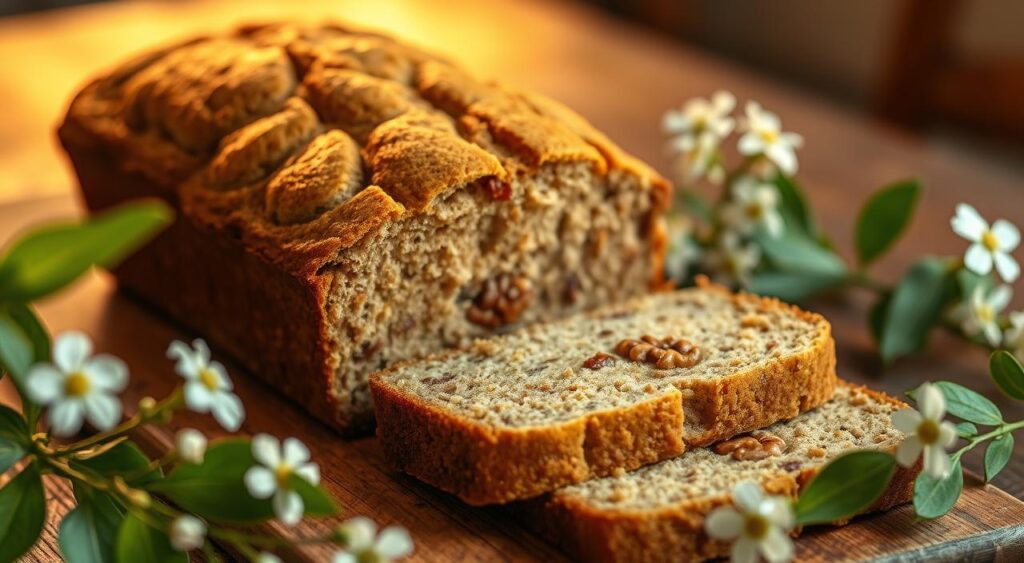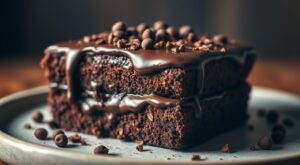Are you looking for a delicious way to support your gut health? Gluten-free banana bread can be a great addition to your diet. Many people have been enjoying banana bread since childhood, and now you can make a healthier version that’s easy to digest.
By incorporating certain ingredients into your banana bread recipe, you can create a treat that not only tastes great but also promotes digestive wellness. This article will guide you through making a simple yet effective gluten-free banana bread that suits your dietary needs.
Key Takeaways
- Learn how to make a delicious gluten-free banana bread that supports gut health.
- Understand the connection between gluten-free eating and digestive wellness.
- Discover the specific ingredients that make this banana bread gut-friendly.
- Find out how to adapt the recipe to suit different dietary needs and preferences.
- Explore how certain foods can enhance gut health and support digestion.
The Connection Between Gluten-Free Eating and Gut Health
The relationship between gluten consumption and digestive health has garnered significant attention in recent years. For individuals with gluten sensitivity or intolerance, consuming gluten can lead to various digestive issues. Research has shown that gluten proteins, specifically gliadin and glutenin, can trigger inflammatory responses in the intestinal lining, causing damage and discomfort.
Understanding the spectrum of gluten sensitivity is crucial. It ranges from celiac disease, an autoimmune disorder that causes the immune system to react to gluten, to non-celiac gluten sensitivity, where individuals experience symptoms similar to celiac disease but without the same level of immune system activation. Both conditions can significantly impact gut health.
Why Gluten Can Cause Digestive Issues
Gluten can cause digestive issues due to its ability to trigger an inflammatory response in the gut. In individuals with gluten sensitivity, the consumption of gluten leads to the release of pro-inflammatory cytokines, which can damage the intestinal lining and disrupt nutrient absorption. This inflammation can result in symptoms such as bloating, abdominal pain, and diarrhea.
| Condition | Effect on Gut | Common Symptoms |
|---|---|---|
| Celiac Disease | Autoimmune reaction damaging the small intestine | Diarrhea, abdominal pain, fatigue |
| Non-Celiac Gluten Sensitivity | Inflammation and irritation of the intestinal lining | Bloating, abdominal pain, diarrhea |
Benefits of Going Gluten-Free for Sensitive Individuals
For individuals sensitive to gluten, adopting a gluten-free diet can significantly improve digestive health. By eliminating gluten, sensitive individuals can reduce inflammation, enhance nutrient absorption, and restore balance to their gut flora. This dietary change can lead to a reduction in symptoms such as bloating and abdominal pain, improving overall gut health and comfort.

Why This Gluten Free Banana Bread Supports Digestive Health
Our gluten-free banana bread is more than just a tasty treat; it’s a digestive health powerhouse. The key to its digestive benefits lies in its carefully chosen ingredients.
Gut-Friendly Ingredients
The star ingredient in our gluten-free banana bread is the banana. To get the strongest, sweetest banana flavor, it’s essential to use overly ripe bananas. These ripe bananas are rich in prebiotic fibers that feed beneficial gut bacteria, supporting a healthy microbiome.
Another crucial component is the gluten-free all-purpose flour blended with xanthan gum. This flour blend provides fiber without the inflammatory effects of gluten, making it easier on the digestive system. Xanthan gum not only helps bind the bread together but also acts as a prebiotic fiber, further supporting gut health.
Synergistic Benefits
When these ingredients come together, they create a synergistic effect that’s greater than their individual benefits. The combination of ripe bananas, gluten-free flour, and xanthan gum works to minimize common gut irritants while maximizing ingredients that soothe and support digestive function.
By choosing this gluten-free banana bread recipe, you’re not only enjoying a delicious treat but also supporting your digestive health. The thoughtful design of this recipe ensures that it is both therapeutic for your digestive system and satisfying to your taste buds.
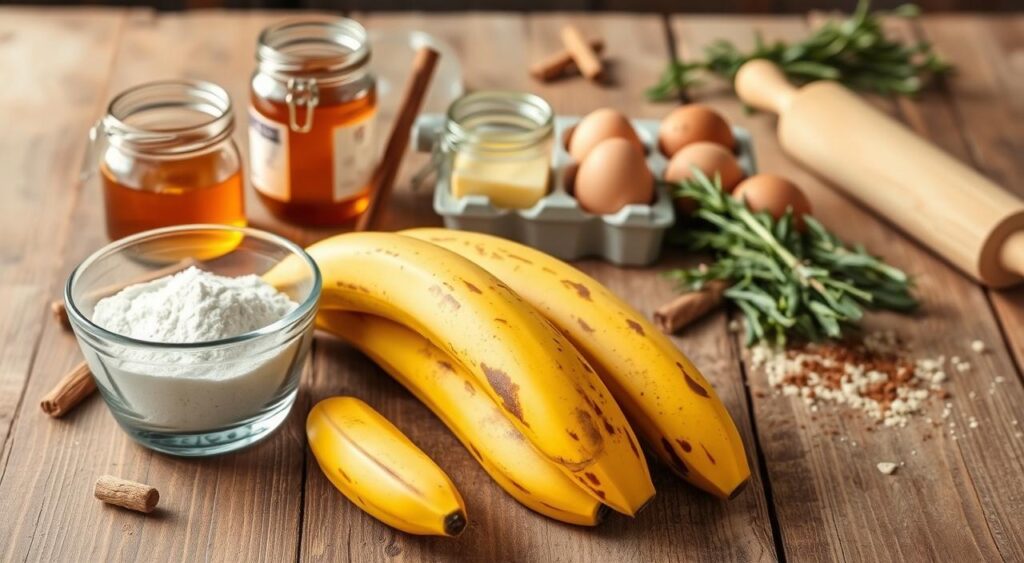
- Ripe bananas provide prebiotic fibers.
- Gluten-free flour offers fiber without gluten’s inflammatory effects.
- Xanthan gum acts as both a binding agent and prebiotic fiber.
By incorporating these gut-friendly ingredients, our gluten-free banana bread recipe supports a healthy digestive system, making it an excellent choice for those looking to reduce digestive distress while still enjoying delicious banana bread.
Key Ingredients for Perfect Gluten Free Banana Bread
The key to a delicious gluten-free banana bread lies in selecting the finest ingredients. To achieve the perfect loaf, it’s essential to understand the role of each component.
Choosing the Right Gluten-Free Flour Blend
Selecting the optimal gluten-free flour blend is crucial. Popular brands like Bob’s Red Mill, King Arthur, and Pillsbury offer varying results. Pillsbury gluten-free flour with xanthan gum is a recommended option.
The Importance of Ripe Bananas
Ripe bananas are the star ingredient, providing natural sweetness and flavor. Ensure they’re overly ripe with brown or black spots for the best results.
Binding Agents: Eggs and Xanthan Gum
Eggs and xanthan gum work together to replace gluten’s structural properties, adding moisture and richness to the bread.
Sweeteners and Flavorings
Granulated sugar sweetens the bread, while pure vanilla extract enhances the banana flavor. You can also experiment with other sweeteners like coconut sugar or honey.
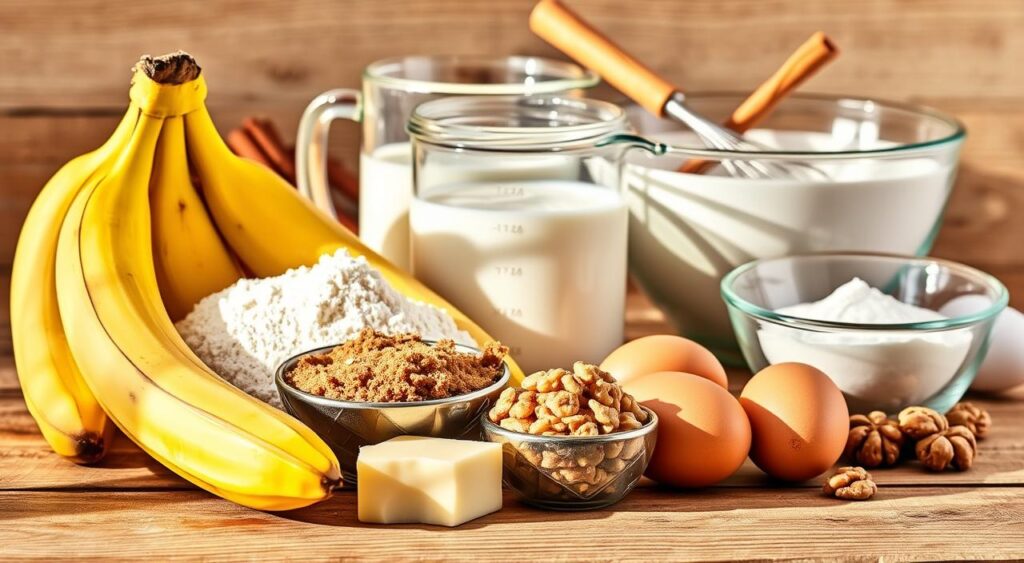
Equipment You’ll Need
To get started, you’ll need a few key pieces of equipment to make your gluten-free banana bread. The right loaf pan is crucial for achieving the perfect shape and texture.
Loaf Pan Recommendations
Choose a pan that’s either 9×5 inches or 8×4 inches, as these sizes are ideal for gluten-free banana bread. Consider the material: metal pans heat evenly, while glass or ceramic pans can affect baking time. Lighter-colored pans prevent over-browning.
| Pan Material | Baking Time | Crust Development |
|---|---|---|
| Metal | Even heating | Crisp crust |
| Glass/Ceramic | Longer baking time | Softer crust |
Mixing Tools and Other Essentials
In a large mixing bowl, mash ripe bananas until smooth. You’ll need a mixing tool, such as a wooden spoon or stand mixer, to combine ingredients. Accurate baking requires precise measuring tools. Optional equipment like banana mashers and parchment paper liners can simplify the process.

Gluten Free Banana Bread Recipe
Here’s a simple recipe for gluten-free banana bread that’s perfect for those looking to improve their gut health. This recipe combines the natural sweetness of ripe bananas with the benefits of gluten-free ingredients.
Ingredients List
To make this delicious banana bread, you’ll need:
- 2-3 very ripe bananas (mashed)
- 1 teaspoon baking soda
- 1/3 cup unsalted butter (melted)
- 3/4 cup granulated sugar
- A pinch of salt
- 2 large eggs (beaten)
- 1 teaspoon pure vanilla extract
- 1 1/2 cups gluten-free all-purpose flour with xanthan gum
- 1/4 teaspoon xanthan gum (optional, depending on your flour)
Step-by-Step Instructions
Follow these steps to bake your gluten-free banana bread:
- Preheat your oven to 350° F and spray a 4 x 8 loaf pan with cooking spray.
- Mash the ripe bananas in a mixing bowl until smooth.
- Add baking soda to the mashed bananas and stir.
- Mix in the melted butter, sugar, salt, eggs, and vanilla extract.
- Combine the gluten-free flour and xanthan gum (if using) into the wet ingredients.
- Pour the batter into the prepared loaf pan.
- Bake for 50 minutes to 1 hour, or until a toothpick inserted in the center comes out clean.
- Cool the bread completely before slicing.
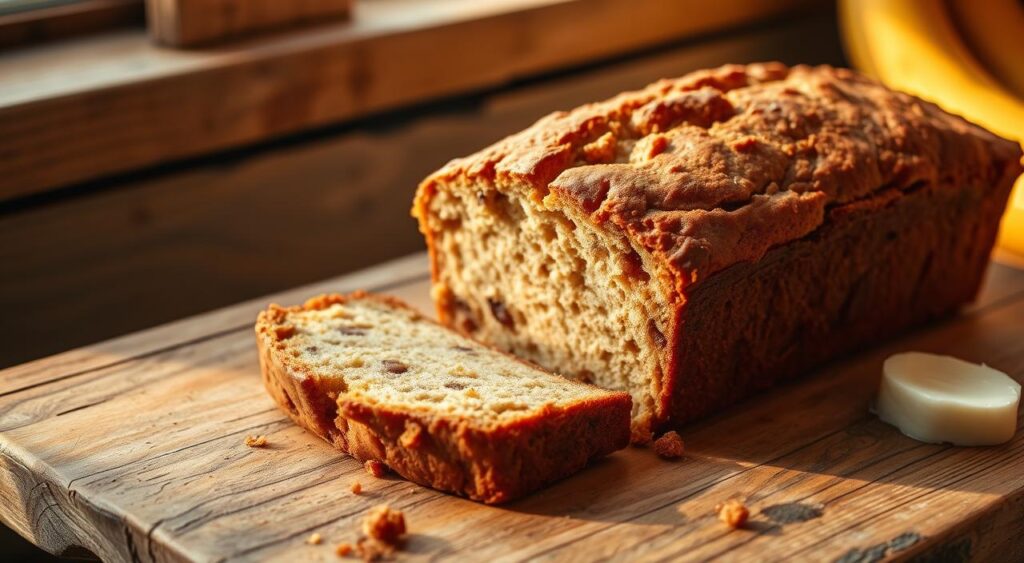
Pro Tips for Baking Success
The key to a delicious gluten-free banana bread lies in the details of its preparation. To ensure your baking endeavors are successful, consider the following expert tips.
Measuring Gluten-Free Flour Correctly
Measuring gluten-free flour accurately is crucial. Use the “spoon & level” method: scoop the flour into the measuring cup with a spoon, then level it off with the back of a knife. This technique prevents packing the flour, ensuring the right consistency in your banana bread.
Room Temperature Ingredients Matter
Always bake with ingredients that are at room temperature. Cold ingredients don’t mix as well with room-temperature ones, potentially affecting the texture of your bread. To bring cold ingredients to room temperature quickly, simply leave them on the counter for about 30 minutes before you start baking.
Testing for Doneness
Baking time is crucial, and checking for doneness is the final step. Bake for 50 minutes to 1 hour or until a toothpick inserted in the center comes clean. Be aware that oven temperatures can vary, so keep an eye on your banana bread to avoid overcooking.
| Tip | Description | Benefit |
|---|---|---|
| Measuring Flour Correctly | Spoon & level method | Prevents dense bread |
| Room Temperature Ingredients | Leave on counter for 30 minutes | Better emulsion and texture |
| Testing for Doneness | Toothpick test | Ensures bread is fully cooked |

Delicious Variations to Try
You can easily customize your gluten-free banana bread to suit different tastes and occasions. This versatility is one of the best things about this recipe.
Add-Ins: Chocolate Chips, Nuts, and Fruits
Adding different ingredients can enhance the flavor and texture of your banana bread. Try incorporating mini chocolate chips, walnuts, or blueberries into the batter. For a delicious twist, you can also use other types of nuts like pecans or almonds, or fruits like cranberries or chopped apples. When adding these ingredients, make sure to fold them gently into the batter to ensure even distribution.
| Add-In | Measurement |
|---|---|
| Mini Chocolate Chips | 1/2 cup |
| Chopped Walnuts | 1/2 cup |
| Blueberries | 1 cup |
Flavor Twists: Spices and Extracts
Experimenting with different spices and extracts can give your banana bread a unique flavor. Try adding a combination of cinnamon and nutmeg or cardamom and ginger to create a warm and aromatic flavor. You can also use almond extract or coconut extract to add a subtle twist to the traditional banana flavor. Start with a small amount (about 1/4 teaspoon) and adjust to taste.

Making It Dairy-Free and Other Dietary Adaptations
Whether you’re looking to make your gluten-free banana bread dairy-free or adjust the sugar content, we’ve got you covered. This section will guide you through various adaptations to suit different dietary needs while maintaining the bread’s quality and taste.
Butter Substitutes
To make your gluten-free banana bread dairy-free, you can swap traditional butter for non-dairy alternatives. Options include Smart Balance or Earth Balance butter, and coconut oil. Using coconut oil not only makes the bread dairy-free but also adds a unique flavor.
Egg Replacements
For those who need to avoid eggs, you can use chia eggs or flax eggs as effective replacements. These alternatives work well in binding the ingredients together.
Sugar Alternatives
If you’re looking to reduce or change the type of sugar in your gluten-free banana bread, consider using coconut sugar or maple syrup. These alternatives can affect the flavor and texture, so some experimentation may be necessary.
| Dietary Need | Adaptation |
|---|---|
| Dairy-Free | Use Smart Balance or Earth Balance butter, or coconut oil |
| Egg-Free | Use chia eggs or flax eggs |
| Lower Sugar | Use coconut sugar or maple syrup |
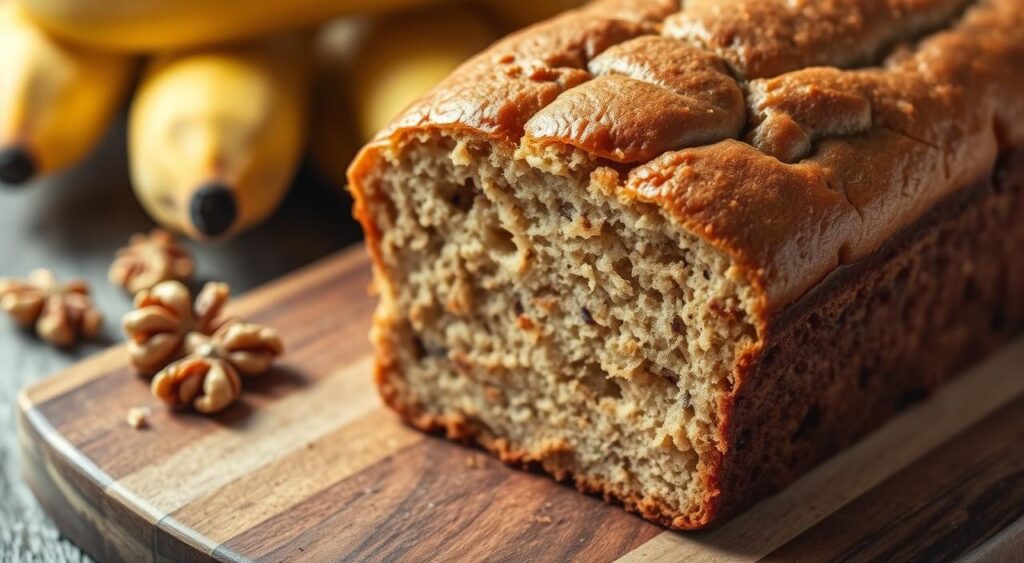
9 Powerful Foods That Enhance Gut Health
Enhancing gut health can be achieved through dietary changes that incorporate specific foods known to support digestive well-being. Certain foods have been shown to significantly improve gut health, and incorporating them into your diet can be beneficial.
Fermented Foods
Fermented foods like yogurt, kefir, and sauerkraut are rich in probiotics, introducing beneficial bacteria directly into your gut microbiome. These foods support a healthy balance of gut bacteria, enhancing digestion and overall gut health.
Fiber-Rich Foods
Oats, flaxseeds, and chia seeds are high in fiber, acting as prebiotics that feed beneficial gut bacteria and promote regular elimination. Including these foods in your diet can help maintain a healthy gut.
Anti-Inflammatory Options
Foods like turmeric, ginger, and berries have anti-inflammatory properties, reducing gut inflammation and supporting healing of the intestinal lining. These foods can be easily incorporated into your daily meals to support gut health.
How to Incorporate These Into Your Daily Diet
To enhance gut health, try incorporating these foods into your daily meals. For example, add ripe bananas to your breakfast, use turmeric in your cooking, or snack on berries Start with small portions and adjust according to your body’s response.
Some simple ways to include these foods are: making a banana smoothie with yogurt and oats, or adding flaxseeds to your salad. Experiment with different recipes to find what works best for you.
- Incorporate fermented foods like yogurt or kefir into your breakfast.
- Add fiber-rich foods like oats or chia seeds to your meals.
- Use anti-inflammatory spices like turmeric in your cooking.
- Snack on berries or other anti-inflammatory fruits.
Storing and Freezing Your Banana Bread
Gluten-free banana bread requires careful storage to preserve its quality and freshness. Proper storage techniques will help you enjoy your banana bread for a longer period.
Counter Storage for Short-Term Freshness
For short-term storage, keep your gluten-free banana bread in an airtight container at room temperature. It will stay fresh for up to 2 days. Ensure the loaf is completely cooled before storing to prevent moisture buildup.
Refrigeration Tips
To extend the freshness, store the banana bread in the refrigerator. Wrap it tightly in plastic wrap and place it in an airtight container. It will remain fresh for up to 5 days.
Freezing Methods for Long-Term Storage
For long-term storage, consider freezing your loaf. Wrap it tightly in plastic wrap and then place it in a freezer-safe bag. When you’re ready to enjoy it, thaw the gluten-free banana bread overnight in the refrigerator or at room temperature.
Conclusion
By baking this gluten-free banana bread, you’re taking a significant step towards supporting your gut health. This recipe combines gut-friendly ingredients that work together to support digestive function, making it perfect for those with gluten sensitivities. You can easily adapt it to suit your dietary needs and preferences. Incorporating this bread into your diet, along with the nine powerful foods that enhance gut health, can be a delicious way to support your overall wellbeing. Experiment with the recipe, make it your own, and share your experiences to help others nurture their gut health.
FAQ
What type of flour is best for gluten-free banana bread?
A blend of gluten-free flours such as almond flour, coconut flour, and rice flour works well for this recipe. You can also experiment with different combinations to find your favorite.
How ripe should the bananas be for this recipe?
The bananas should be very ripe, as they will be sweeter and blend into the batter more easily. You can check for ripeness by looking for brown spots on the skin.
Can I make this recipe in a different pan, like a muffin tin?
Yes, you can make muffins using this recipe. Simply divide the batter evenly among the muffin cups and adjust the baking time to about 20-25 minutes, or until a toothpick comes out clean.
How do I store leftover loaf to keep it fresh?
You can store the cooled loaf at room temperature in an airtight container for up to three days. For longer storage, wrap it tightly and refrigerate or freeze.
Can I customize this recipe with chocolate chips or walnuts?
Absolutely! Adding chocolate chips or walnuts can enhance the flavor and texture of your gluten-free banana bread. Simply fold them into the batter before pouring it into the loaf pan.
Why is it important to preheat the oven before baking?
Preheating the oven ensures that your gluten-free banana bread bakes evenly and at the right temperature, which is crucial for achieving the perfect texture.
How do I know when the bread is done baking?
You can check for doneness by inserting a toothpick into the center of the loaf. If it comes out clean or with a few moist crumbs, the bread is ready.
